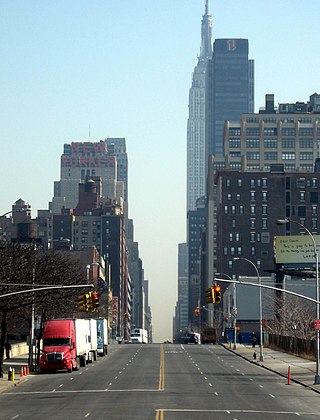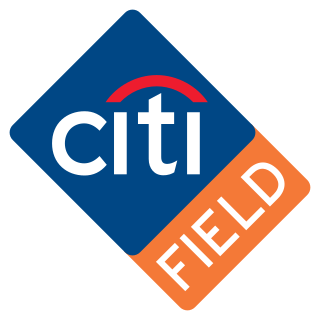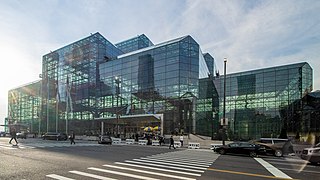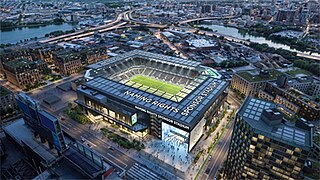
Flushing Meadows–Corona Park, often referred to as Flushing Meadows Park, or simply Flushing Meadows, is a public park in the northern part of Queens in New York City, New York, U.S. It is bounded by I-678 on the east, Grand Central Parkway on the west, Flushing Bay on the north, and Union Turnpike on the south. Flushing Meadows–Corona Park is the fourth-largest public park in New York City, with a total area of 897 acres (363 ha).

The Mets–Willets Point station is a rapid transit station on the IRT Flushing Line of the New York City Subway. Located near the Citi Field baseball stadium, it is served by the 7 train at all times and by the express <7> train rush hours in the peak direction or after sporting events. This station is located near Flushing Meadows–Corona Park in Willets Point, Queens, on Roosevelt Avenue between 114th and 126th Streets.
West Side Stadium was a proposed football and Olympic stadium to be built on a platform over the rail yards on the West Side of Manhattan in New York City.
The IRT Flushing Line is a rapid transit route of the New York City Subway system, named for its eastern terminal in Flushing, Queens. It is operated as part of the A Division. The Interborough Rapid Transit Company (IRT), a private operator, had constructed the section of the line from Flushing, Queens, to Times Square, Manhattan between 1915 and 1928. A western extension was opened to Hudson Yards in western Manhattan in 2015, and the line now stretches from Flushing to Chelsea, Manhattan. It carries trains of the 7 local service, as well as the express <7> during rush hours in the peak direction. It is the only currently operational IRT line to serve Queens.

34th Street is a major crosstown street in the New York City borough of Manhattan. It runs the width of Manhattan Island from West Side Highway on the West Side to the FDR Drive on the East Side. 34th Street is used as a crosstown artery between New Jersey to the west and Queens to the east, connecting the Lincoln Tunnel to New Jersey with the Queens–Midtown Tunnel to Long Island.

Citi Field is a baseball stadium located in Flushing Meadows–Corona Park, in the borough of Queens, New York City, United States. Opening in 2009, Citi Field is the home ballpark of Major League Baseball (MLB)'s New York Mets. The stadium was built as a replacement for the adjacent Shea Stadium, which had opened in 1964.

The Jacob K. Javits Convention Center, commonly known as the Javits Center, is a large convention center on Eleventh Avenue between 34th Street and 38th Street in Hell's Kitchen, Manhattan, New York City. It was designed by architect James Ingo Freed of Pei Cobb Freed & Partners. The space frame structure was constructed from 1979 to 1986 and was named to honor Jacob Javits, the United States Senator for New York. When the Javits Center opened, it replaced the New York Coliseum at Columbus Circle as the city's major convention facility; the Coliseum was subsequently demolished and replaced by Time Warner Center.

Hudson Yards is a neighborhood on the West Side of Midtown Manhattan in New York City, bounded roughly by 30th Street in the south, 41st Street in the north, the West Side Highway in the west, and Eighth Avenue in the east. The area is the site of a large-scale redevelopment program that is being planned, funded, and constructed under a set of agreements among the State of New York, City of New York, and Metropolitan Transportation Authority (MTA), with the aim of expanding the Midtown Manhattan business district westward to the Hudson River. The program includes a major rezoning of the Far West Side, an extension of the New York City Subway's 7 and <7> trains to a new subway station at 34th Street and 11th Avenue, a renovation and expansion of the Javits Center, and a financing plan to fund the various components. The various components are being planned by New York City Department of City Planning and New York City Economic Development Corporation.
The 7 Subway Extension is a subway extension of the New York City Subway's IRT Flushing Line, which is served by the 7 local and <7> express services. The extension stretches 1.5 miles (2.4 km) southwest from its previous terminus at Times Square, at Seventh Avenue and 41st Street, to one new station at 34th Street and Eleventh Avenue. A second station at 10th Avenue and 41st Street was dropped from the plans in October 2007. The entirety of the extension is located within the New York City borough of Manhattan. The extension, a key part of the Hudson Yards Redevelopment Project, is expected to bring business and entertainment into the area, as well as aid redevelopment of nearby Chelsea and Hell's Kitchen, located around the Long Island Rail Road's West Side Yard. The extension also serves the nearby Jacob K. Javits Convention Center.

Sports in the New York metropolitan area have a long and distinguished history.

The Boroughs of New York City are the five major governmental districts that compose New York City. The boroughs are the Bronx, Brooklyn, Manhattan, Queens, and Staten Island. Each borough is coextensive with a respective county of the State of New York: The Bronx is Bronx County, Brooklyn is Kings County, Manhattan is New York County, Queens is Queens County, and Staten Island is Richmond County.
Alexander Garvin was an American urban planner, educator, and author. At the time of his death, he was in private practice at AGA Public Realm Strategists in New York City and was also an adjunct professor at the Yale School of Architecture, where he taught from 1967 on. He is widely known for having created the vision plan of Atlanta's proposed greenbelt park system, the Atlanta BeltLine, serving as planning director for New York City's 2012 Olympic Games bid, and overseeing efforts to redevelop lower Manhattan after the September 11th attacks as Vice President of Planning, Design, and Development for the Lower Manhattan Development Corporation. Garvin also authored a number of books on the subject of planning including The Planning Game: Lessons from Great Cities and The American City: What Works, What Doesn't. Garvin also served in a variety of positions in New York City government including director of comprehensive planning.

Daniel Louis Doctoroff is an American businessman and former government official. From 2015 to 2021, he served as chief executive officer of Sidewalk Labs, a startup company he helped found focused on technology for city life. Previously, he was the CEO and president of Bloomberg L.P., deputy mayor for economic development and rebuilding for the New York City under Mike Bloomberg from January 2002 – December 31, 2007, led New York City's bid for the 2008 and 2012 Summer Olympics, and was a managing partner at Oak Hill Capital Partners, a private equity investment firm.

Flushing Avenue is a street running through northern Brooklyn and western Queens, beginning at Nassau Street in Fort Greene, Brooklyn, and ending at Grand Avenue in Maspeth. It divides the neighborhood of Williamsburg from Clinton Hill and East Williamsburg from Bushwick. After crossing the Queens border, the avenue serves as the dividing line between Ridgewood, Queens and West Maspeth. Flushing Avenue then terminates in Maspeth. Despite its name, however, the avenue does not extend to Flushing.
The West Side of Manhattan refers to the side of Manhattan Island that abuts the Hudson River and faces the U.S. state of New Jersey. The West Side is home to several famed New York City locations, including Fifth Avenue, Central Park, and lower Broadway. The major neighborhoods on the West Side are Inwood, Hudson Heights, Washington Heights, West Harlem, Morningside Heights, Manhattan Valley, the Upper West Side, Hell's Kitchen, Chelsea, the West Village, SoHo, and Tribeca. The 8th Avenue and West Side subway lines connect all parts of the West Side.

Transportation in New York City has ranged from strong Dutch authority in the 17th century, expansionism during the industrial era in the 19th century and half of the 20th century, to cronyism during the Robert Moses era. The shape of New York City's transportation system changed as the city did, and the result is an expansive modern-day system of industrial-era infrastructure. New York City, being the most populous city in the United States, has a transportation system which includes one of the largest subway systems in the world; the world's first mechanically ventilated vehicular tunnel; and an aerial tramway.

The West Side Yard is a rail yard of 30 tracks owned by the Metropolitan Transportation Authority on the west side of Manhattan in New York City. Used to store commuter rail trains operated by the subsidiary Long Island Rail Road, the 26.17-acre (10.59 ha) yard sits between West 30th Street, West 33rd Street, 10th Avenue and 12th Avenue. Since the early 2010s, the eastern part of the yard has been covered by the Hudson Yards complex of skyscrapers and other buildings.

The 34th Street–Hudson Yards station is a New York City Subway station in Manhattan's West Side on the IRT Flushing Line, and is the western terminus for the 7 local and <7> express services. It has two tracks and one island platform, with two levels of mezzanines: one directly above the platform and the other directly below street level. The station directly serves the Hudson Yards mega-development above it, and is located within the greater Hudson Yards neighborhood. The station contains two entrances along Hudson Boulevard: a primary entrance south of 34th Street, and a secondary entrance south of 35th Street.

The New York City FC stadium is a proposed soccer-specific stadium to be built in Willets Point in the New York City borough of Queens for New York City FC of Major League Soccer (MLS), who currently play home games at Yankee Stadium and Citi Field. Construction is scheduled to begin in summer or fall of 2024 and is expected to be completed in 2027.

Hudson Yards is a 28-acre (11 ha) real estate development in the Hudson Yards neighborhood in Manhattan, New York City, between the Chelsea and Hell's Kitchen neighborhoods. It is located on the waterfront of the Hudson River. Upon completion, 13 of the 16 planned structures on the West Side of Midtown South would sit on a platform built over the West Side Yard, a storage yard for Long Island Rail Road trains. The first of its two phases, opened in 2019, comprises a public green space and eight structures that contain residences, a hotel, office buildings, a mall, and a cultural facility. The second phase, on which construction had not started as of 2023, will include residential space, an office building, and a school.

















